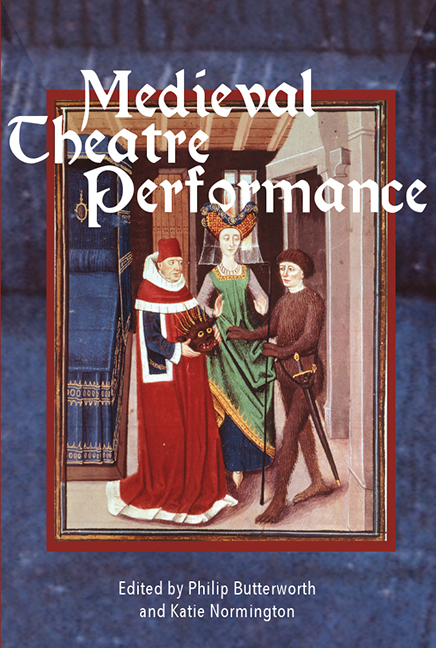Book contents
- Frontmatter
- Dedication
- Contents
- List of Illustrations
- Contributors
- Abbreviations of Principal Sources Cited
- Introduction
- Synopses
- 1 From Archive to Repertoire: The Disguising at Hertford and Performing Practices
- 2 Walk, Talk, Sit, Quit? On What Happens in Netherlandish Rhetoricians’ Plays
- 3 Performing Intrusions: Interaction and Interaxionality in Medieval English Theatre
- 4 Player Transformation: The Role of Clothing and Disguise
- 5 Pavilioned in Splendour: Performing Heaven in Fifteenth-Century Florence
- 6 Living Pictures: Drama without Text, Drama without Action
- 7 Performer-Audience Relationships in Fifteenth- and Sixteenth-century Danced Spectacles
- 8 Decadance in the Late Middle Ages: The Case of Choreomania
- 9 Writing, Telling and Showing Horsemanship in Rhetoricians’ Farce
- 10 Inanimate Performers: The Animation and Interpretive Versatility of the Palmesel
- 11 ‘lyke unto a lyvelye thyng’: The Boxley Rood of Grace and Medieval Performance
- 12 The Mechanycalle ‘Ymage off Seynt Iorge’ at St Botolph's, Billingsgate, 1474
- Bibliography
- Index
7 - Performer-Audience Relationships in Fifteenth- and Sixteenth-century Danced Spectacles
Published online by Cambridge University Press: 21 August 2018
- Frontmatter
- Dedication
- Contents
- List of Illustrations
- Contributors
- Abbreviations of Principal Sources Cited
- Introduction
- Synopses
- 1 From Archive to Repertoire: The Disguising at Hertford and Performing Practices
- 2 Walk, Talk, Sit, Quit? On What Happens in Netherlandish Rhetoricians’ Plays
- 3 Performing Intrusions: Interaction and Interaxionality in Medieval English Theatre
- 4 Player Transformation: The Role of Clothing and Disguise
- 5 Pavilioned in Splendour: Performing Heaven in Fifteenth-Century Florence
- 6 Living Pictures: Drama without Text, Drama without Action
- 7 Performer-Audience Relationships in Fifteenth- and Sixteenth-century Danced Spectacles
- 8 Decadance in the Late Middle Ages: The Case of Choreomania
- 9 Writing, Telling and Showing Horsemanship in Rhetoricians’ Farce
- 10 Inanimate Performers: The Animation and Interpretive Versatility of the Palmesel
- 11 ‘lyke unto a lyvelye thyng’: The Boxley Rood of Grace and Medieval Performance
- 12 The Mechanycalle ‘Ymage off Seynt Iorge’ at St Botolph's, Billingsgate, 1474
- Bibliography
- Index
Summary
During the late medieval and early modern periods dancing was ubiquitous throughout society, taking place in a variety of venues, from churchyards and village streets, and specially constructed dance halls, to the indoor spaces reserved for the elite. It is the latter—the dance performances at the courts of France, Italy and England—that are the principal subject of this essay. By ‘elite’ I am referring to the families at the top of the social pyramid who held political power, regardless of what political system was operating: that is, whether the state was a monarchy, a ducal court or a republic. Thus the elite included members of the nobility, gentry, knights and ambassadors, the families whom the fifteenth- century Italian Antonio Cornazano was addressing in his dance treatise when he said, ‘We come to these balli and bassadanze which are removed from the populace, and are composed for the noble halls, and are to be danced only by the most worthy ladies, and not by the common multitude of people.’
The dances of the elite did not, of course, remain solely within that restricted circle. The wealthy middle class, merchants and lawyers were just as interested in dance as those in the upper level of society and just as keen to learn the dances performed by the elite. Thus dances first choreographed for court balls were later learned and performed by members of the middle class, as in 1517 in Bologna when dances recorded fifty to sixty years earlier in the treatise of Guglielmo Ebreo were performed at balls for the urban merchant and university communities.
Even though documentary evidence has survived concerning the dance practices of the upper levels of society, the picture is incomplete, especially when considering actual dance performances. For this period much of the information we do have comes from a small number of treatises written by dance masters, the majority from Italy and France, with a very small number from England and Spain. One has to be aware, however, that what was written by the dance masters in their treatises on the nature and fundamental principles of their dance practices might not have been always carried over into performances. Examination of the relationships between performers and audiences for danced spectacles at court is one method by which we can understand more clearly what happened on the dance floor during these events.
- Type
- Chapter
- Information
- Medieval Theatre PerformanceActors, Dancers, Automata and their Audiences, pp. 123 - 140Publisher: Boydell & BrewerPrint publication year: 2017



